Multi-layered radiation converter
- Summary
- Abstract
- Description
- Claims
- Application Information
AI Technical Summary
Benefits of technology
Problems solved by technology
Method used
Image
Examples
Embodiment Construction
[0042]Throughout the drawings, the same reference characters will be used for corresponding or similar elements.
[0043]FIG. 3 is a schematic cross-sectional view of a converter stack according to a preferred embodiment of the invention. In this particular example, the converter stack 30 comprises two converter layers 32-1 and 32-2, each of which has a number of drift holes defined therein. Each converter layer preferably includes two electrode layers 34 separated by a support structure 35. The support structure 35 is normally made of an insulating material, and the electrode layers 34 may simply be a metallization on both sides of the insulating material. The converter layers 32-1 and 32-2 are preferably arranged in a conventional framework (not shown), possibly using dielectric spacers if required.
[0044]The converter stack 30 generally has connection terminals for connecting the converter to an electric field generator for providing an electric drift field in a direction substantial...
PUM
 Login to View More
Login to View More Abstract
Description
Claims
Application Information
 Login to View More
Login to View More - R&D
- Intellectual Property
- Life Sciences
- Materials
- Tech Scout
- Unparalleled Data Quality
- Higher Quality Content
- 60% Fewer Hallucinations
Browse by: Latest US Patents, China's latest patents, Technical Efficacy Thesaurus, Application Domain, Technology Topic, Popular Technical Reports.
© 2025 PatSnap. All rights reserved.Legal|Privacy policy|Modern Slavery Act Transparency Statement|Sitemap|About US| Contact US: help@patsnap.com



